Furniture Shopping
How to Shop for Fine Furniture like a Pro?
Furniture shopping is fun and rewarding. As the owners of Bohemian’s, we do it nearly everyday. Unlike our customers, however, we have to make decisions quickly, and competitively. Because we purchase the majority of our goods from large Estate Sales from some of the largest auction houses in the country, we regularly have to sort through over 6000 pieces of fine furniture in a room to find the absolute BEST for our small furniture showroom.
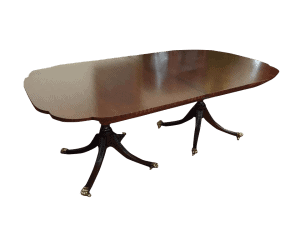
Fine Furniture
Years of experience and a keen eye have taught us to be sharp, mean and bold. (And being a 6 ft + tall man helps, it really does…) But, all auction drama aside, we have learned some great tips that can take anyone from a clueless furniture novice to a true fine furniture pro.
Here are our top FIVE tips to bare in mind when shopping for furniture.
1. Curb appeal can be misleading.
Have you ever driven up to a beautiful home with a great castle-like exterior but found the interior to look cheap or unfinished?
Modern, factory-made furniture stores can definitely lead shoppers to poor decisions and a lifetime of buyers remorse. We like to call it the “Shiny Penny Phenomenon.” Espresso and cherry finishes with a coat of gloss (think a brand new shiny penny) can make even the weakest low quality woods look great– for a few weeks that is. Often that shiny color belies a fast growing soft wood, or worse, a faux wood material. “A shiny penny is not worth more than a dull nickle” but often, especially young shoppers are drawn to that glossy deceptive finish.
Most modern furniture makers use composite woods (pressed board), mdf or fiberboard in their products. 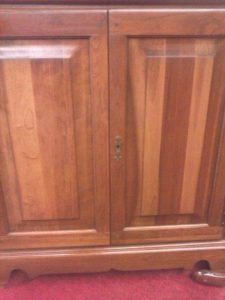
Look for real wood grain to be carried through to the back of a piece. Take out drawers and see what material is used in between or on the back of case goods. Nothing can compare with real hardwoods like maple, walnut, cherry and oak. Remember, wood is your friend, wood is your friend, people.
2.Look with your eyes AND your hands…
Make no mistake: we are not telling you to slam drawers, or scratch a diamond ring on a table. Being “hands on” doesn’t mean treating furniture like a batch of pizza dough. We are talking about a gentle, careful stroke along the top and sides of a piece of fine furniture. Think of a piece of furniture as a baby kitten. Or a baby kitten with an adorable little cast on its leg and a bandage on its head. In other words, easy does it, furniture shoppers.
But furniture is a tactile business and your touch can sometimes tell you more about a piece than first sight. Wood furniture, especially antique furniture, has been planed by the hands of a craftsman and should feel smooth. Roughness on a finish can be a sign that the piece wasn’t well cared for. Water and heat are usually the causes of a raised or textured finish. 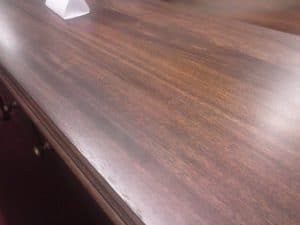
But extreme cold can do a number too. Often, furniture stored in a cold or damp place can cause wood to shrink and warp. There is a natural swelling and shrinking of organic material (like trees) that happens to a certain degree seasonally. But too much cold or extreme changes can start popping even the hardest woods. Run your hands along the sides of a dresser or table to feel for cupping or splitting. Once the boards of a table have started cupping, you pretty much have to walk away from this piece, no matter how pretty it may be.
As for antiques, there is a certain degree of acceptance of its “signs of life.” Chips, a time worn finish or marks of imperfection are normally considered desirable marks of character on an Antique. But this character has a tipping point. Nobody wants a piece so rustic that it no longer serves its basic purpose. We see some pieces where a light dusting causes it to flake, or worse give you a splinter. In the case of antiques, focus on whole overall condition. The integrity of an antique is one of the most vital sign of its value. Do drawers function on a basic level? Does a secretary support itself? Could this chair hold a person’s weight? How is that back leg looking? Remember, antiques are something that should be appreciated for function as well as looks.
3. Know your joints. 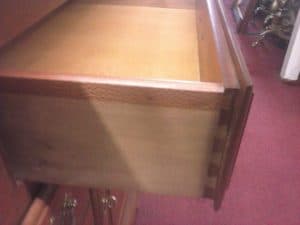
Certain marks of craftsmanship and construction separate the Fine from the Finer when it comes to furniture. Beveled edges, inlay woods, dovetailed drawers, pin and mortised chair rungs… all of these age-old techniques have been used by the masters for centuries. 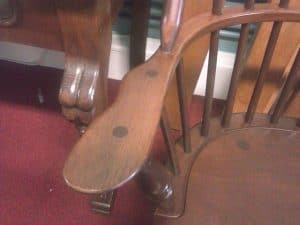
Wood to wood joints are simply the easiest to repair and rebuild, if problems do arise, whereas screws and metal fasteners can break or rust. Stay away from drawers with metal glides, or worse plastic pieces that open drawers. When you want furniture that will last a lifetime, stick with quality vintage makers, custom hand made pieces, or antiques that have stood the test of time.
4. Size and Scale matter.
Scale and size are key to making sure a piece is not going to look down right stupid in your home. Furniture stores, ours included, are unintentionally deceptive when it comes to scale, so when entering one, make sure to look up and realize the ceilings are probably much taller than yours at home. (Ok, obvious exception, Donald Trump houses out there.) Everything is going to look bigger (and hopefully better) in your home. Get some basic dimensions of the spots you are trying to fill and try to make sure there is a bit of room between the piece and trim on the walls and windows. There is nothing worse than an overpowering piece in a tiny room or vice versa. The pieces in a room should relate to each other, but height can vary to give interest. 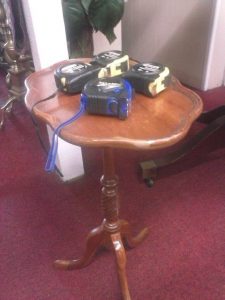
If you have tight hallways, depth of a piece is really important too. 36″ is the most comfortable size of a hallway so if you decide to put something in there, make sure you have comfortable room to open doors and drawers and that you are not setting yourself and your loved ones up for a lifetime of stubbed toes and shin bruises.
Coffee tables should be proportional to the sofa, in height, width and depth. So bring the dimensions of the sofa with you when shopping for end tables and coffee tables.
If you live in an older home, and the piece has to go through tight hallways or stairwells and you are not sure it will pass through, consider cutting out a piece of cardboard that is the width and depth of the piece you are considering and pass it through your home. If you can’t make turns with a cardboard rectangle, you can’t make turns with a piece of furniture.
5. Be prepared to use your gut.
Furniture, like house shopping and dating, takes more than just knowledge of the facts however. Because you are going to live with your decisions for presumably a lifetime (or that is the goal, anyways), you have to love what you choose. Ask yourself, is this something that you are going to enjoy looking at every morning over coffee and appreciate more as time goes on. The beauty of fine furniture is in the details… the way the carvings hug the corners or the uniqueness of the grain, or the waviness of the glass… these are the things that you will notice when you start to live with a piece. 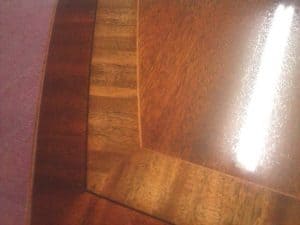
Certain pieces that we have passed up (or worse, sold instead of kept!) are like the “ones that got away” and almost every woman I meet in the store has had that “Why didn’t I…” story of regret about a Victorian dining room set or a mahogany secretary hidden somewhere in their pasts. Most antiques truly are one of a kind, and can not be reproduced even by the best craftspeople.
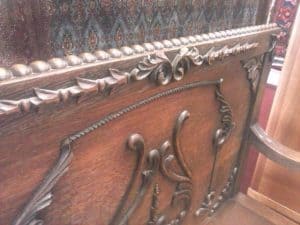
And on the other hand, we have met the people that will rebuild counters, change their home’s layout, or (yes this really happened) cut a hole in their ceiling in order to make that special piece fit into their lives. So if you feel a passion burning in your heart and soul about a piece of furniture. Trust it. It is probably meant to be.
Thank you for furniture shopping with us!
Greg Haute Bohème
Antique Chairs
